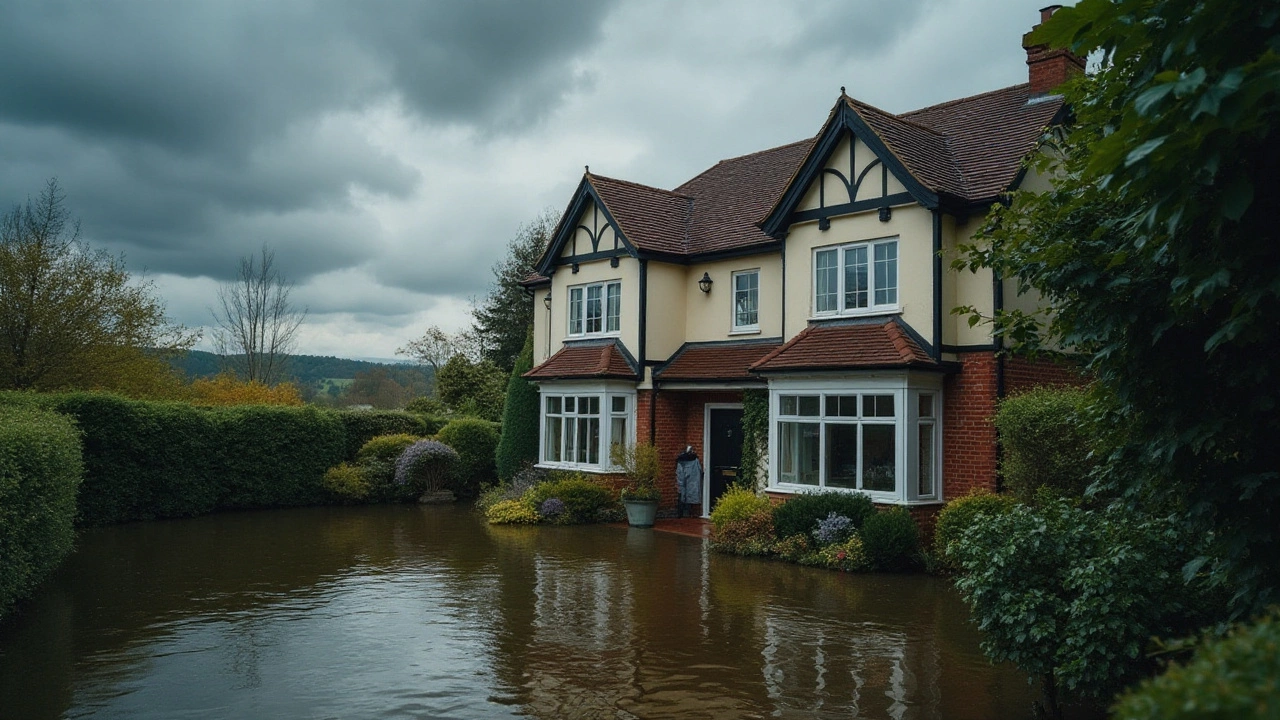Your home is likely one of your most substantial investments, and homeowners insurance is designed to protect it from a variety of misfortunes. However, like many insurance policies, it comes with its own set of limitations that may leave you vulnerable to certain risks. It's crucial to be aware of these potential blind spots so that you can plan accordingly and avoid any financial discomfort.
Among the myriad of conditions that homeowners insurance covers, there are a few notable exceptions that might surprise you. Water damage and mold are frequently not part of standard policies, leaving homeowners burdened with the cost of repairs after the fact. It's valuable to learn what typically falls outside the protection of your insurance to anticipate and mitigate those gaps effectively.
In this article, we delve into some of these common exclusions—specifically flooding and mold infestation—and discuss practical steps you can take to ensure your home is comprehensively protected. Through understanding and securing additional policies like flood insurance or specialized coverage, you can sleep easier knowing your home is safeguarded against potential mishaps. Becoming informed is key to making the right insurance choices.
- Understanding Homeowners Insurance Basics
- Commonly Excluded Events
- Flooding and Water Damage
- Mold and Termite Troubles
- Tips for Comprehensive Coverage
Understanding Homeowners Insurance Basics
Homeowners insurance is a safety net that encloses several aspects of homeownership into one comprehensive package. Designed to protect not just the physical structure of your home, but also your personal belongings and liability in the event of untoward incidents, its importance cannot be overstated. These policies usually cover perils like fires, theft, certain natural disasters, and other unforeseen events that could potentially cause significant damage. Not many realize that standard policies have caps on coverage, meaning that the replacement costs might exceed what your insurance will pay. Therefore, understanding the specific terms of your insurance policy is crucial, ensuring that you are adequately covered without surprise shortfalls when you need it most.
Detailed attention must be paid to the various types of coverage available within a standard homeowners insurance policy. These usually include dwelling protection, which covers the house itself; personal property coverage, which extends to the contents of your home; and liability protection, which provides for legal responsibility and expenses if someone is injured on your property. While these might seem straightforward, the intricacies lie in the limitations and deductibles, which vary significantly from policy to policy. Reading the fine print can reveal deductibles and limits that may require out-of-pocket expense should disaster strike. A notable source, the Insurance Information Institute, advises homeowners to conduct regular reviews of their policies to ensure they reflect current conditions.
Their research suggests, "The cost of rebuilding after a disaster often surprises homeowners, making it imperative to update coverage limits regularly."
Another significant component of homeowners insurance is the endorsements or riders, which are additional coverages added to a policy to provide protection for specific, often excluded, perils. These endorsements can fill gaps, like higher limits for jewelry or protection against earthquakes. Although the basic policy offers a good degree of protection, securing these add-ons can be a wise decision, especially if you live in areas prone to earthquakes or possess high-value items. Discussing these options with your insurance agent can open up realms of coverage you might not have considered. Questions about the cost of these endorsements lead to an understanding of the risks they mitigate, often worth every penny should an unfortunate event occur.
To ensure adequate protection, it's advisable to conduct a personal property inventory. This list describes every item in your home along with its approximate purchase price and any pertinent receipts or appraisals. Doing this can streamline the claims process in the event of a loss, as you will have a comprehensive record of what was in your home. Many homeowners are also unaware of the meaning or consequences of "actual cash value" versus "replacement cost" coverage. The former reimburses the depreciated value of lost items, whereas the latter ensures you receive enough to replace the item in today's market. Choosing replacement cost coverage generally provides better financial security, though it typically comes at a higher premium.
Finally, understanding your policy's exclusions is essential. Natural disasters like earthquakes and floods often require separate policies. The National Flood Insurance Program, for instance, provides flood coverage that is not typically available in standard policies. Being aware of these exclusions allows homeowners to seek supplemental insurance in areas prone to certain hazards, effectively filling gaps in coverage. Recognizing these elements leads to informed decisions about purchasing additional protection and securing peace of mind in knowing that you are adequately covered.
Commonly Excluded Events
When it comes to homeowners insurance, understanding which events are excluded can be just as important as knowing what's covered. Many homeowners are surprised to learn that standard policies exclude certain occurrences that can lead to significant out-of-pocket expenses. One of the most prominent exclusions is flooding. Standard policies typically do not cover water damage resulting from natural floods. This is a realization that comes too late for many, leaving them burdened when disaster strikes. To combat this, homeowners can consider supplemental policies tailored specifically for flood coverage. This kind of foresight can prevent financial distress in areas prone to heavy rains and hurricanes.
While flooding has quite a reputation for not being covered, it is not alone. Damage related to mold is another issue frequently not included in standard homeowners insurance. Mold can develop rapidly due to unseen leaks or prolonged exposure to moisture, and it can cause not only damage to property but also extensive health problems. Many insurance providers argue that mold is a preventable issue, and thus do not cover it. Substantial remediation costs often ensue, making additional mold coverage a wise choice. Balancing the peace of mind from comprehensive insurance with the effort to stay vigilant about potential mold growth is essential for every diligent homeowner.
“Insurance won’t cover what’s preventable; that’s the responsibility of informed ownership.” - Robert Patton, Insurance Expert
Other commonly overlooked exclusions include general wear and tear and acts of war. Insurance is meant to back losses from sudden and accidental events, not those that come from gradual degradation. This means that as roofs age or plumbing systems gradually fail, the costs associated with aging are typically the owner's responsibility. Similarly, damage from acts of war or nuclear hazards is not covered. These exclusions make a strong case for regular home maintenance, ensuring every component is equipped to last. By securing proper inspections and maintenance routines, homeowners can effectively mitigate risks associated with these exclusions.
For those residing in earthquake-prone regions, another exclusion they should be wary of is earthquake damage. Just as with floods, earthquakes can wreak havoc, destroying structures in mere moments. Regular homeowners insurance won’t provide the salvation one might hope for in such events. Instead, purchasing earthquake insurance, often as an added endorsement or a separate policy, is advised. While it might seem like an inconvenience or additional cost, having such coverage can mean the difference between financial ruin and recovery. Highlighting the importance of region-specific coverage is imperative to safeguarding property and peace of mind.

Flooding and Water Damage
When considering the protection of your home, it is essential to understand where traditional homeowners insurance policies may fall short. Flooding, in particular, is one major peril often overlooked yet increasingly common due to changing climates and unexpected weather patterns. Standard homeowners insurance typically does not cover flooding and water damage, leaving homeowners to face potentially devastating repair costs on their own. Each year, homes that never historically faced flooding issues are finding themselves at risk, which underscores the importance of separate flood insurance policies.
The National Flood Insurance Program (NFIP), administered by FEMA, reports that even one inch of water in a home can cause over $25,000 in damage. Such statistics highlight the potential financial burden that could arise from inadequate coverage. A common misconception is that flood insurance is unnecessary unless a home is within a designated floodplain. However, more than 20% of flood insurance claims come from properties outside high-risk areas, according to FEMA's own data. This should be a wake-up call for any homeowner.
"Floods are the most common and widespread of all weather-related natural disasters," says a spokesperson for the Insurance Information Institute. "Understanding the extent to which you’re covered—or not—by your current insurance is critical."
Beyond just major flood events, even internal water damage can be a tricky area with homeowners insurance. The differentiation often comes down to whether the water came from inside or outside the home. For instance, if a pipe bursts or an appliance malfunctions, your policy might cover the ensuing damage. Nevertheless, typical exclusions include damage from gradual leaks, seepage, or unresolved maintenance issues. Therefore, knowing the nuances of your insurance terms is crucial.
To best protect your home from financial fallout due to water damage, homeowners should consider taking a few proactive steps. First, evaluate the flood risk in your area, which may involve consulting flood maps and speaking to local experts. Additionally, securing a dedicated flood insurance policy through the NFIP or private insurers is a sound strategy. It's also wise to perform routine maintenance on plumbing systems and ensure that all gutters and downspouts are clear to help manage runoff effectively.
There is also increasing innovation in home technology that may offer protection through early detection of leaks or potential flooding threats. For example, installing water sensors or smart home systems that alert you to water presence can be a valuable prevention tool, potentially bypassing extensive damage before it becomes unmanageable. Proactive measures like these, combined with appropriate insurance considerations, can considerably lessen the potential impact of water damage, safeguarding your most valuable asset—your home.
Mold and Termite Troubles
For many homeowners, the discovery of mold or termites is met with dread and frustration. These issues not only threaten the structural integrity of a house but can also result in significant financial outlays. Surprisingly, these problems are often not covered by standard homeowners insurance policies. The exclusion usually stems from the nature and causes of these damages. Mold can form from untreated or neglected water damage, while termites are a silent disruptor, chipping away at a home often without immediate visible consequences. Knowing this makes it imperative for homeowners to understand not just the dangers posed by mold and termites, but also why insurers often draw the line at covering the costs associated with their damage.
Tackling mold first, it's a pervasive issue that can grow unnoticed in dark, damp corners of your home, such as under sinks or behind walls. Mold, especially black mold, poses health risks, exacerbating allergies and respiratory conditions among other things. Insurance companies typically place the onus on homeowners to maintain their homes adequately—expecting preventive measures to forestall mold growth. Mold resulting from ignored leaks or floods may find you footing the bill as insurers often deem such circumstances preventable through regular maintenance and timely repairs. This reasoning underlines why mold damages fall under the 'maintenance' category of exclusions in most policies.
Termites, on the other hand, are a homeowner's nightmare due to their stealth and destructive potential. Often undetected until severe damage occurs, termites can hollow out wooden structures, leading to costly repairs. While mold is associated with moisture control, termite prevention necessitates more proactive measures, like regular inspections and soil treatment. Most insurance providers view termite infestations as preventable through vigilant care and, similar to mold, classify the resulting damage outside of their scope due to the expectation that regular inspections will avert major infestations.
"Homeowners often overlook the red flags until it’s too late," noted by a spokesperson from the National Pest Management Association, “yet prevention is key in mitigating costs not covered by insurance.”
Given these exclusions, homeowners must take proactive steps to safeguard their homes. Hiring professionals for a comprehensive evaluation and implementing a maintenance schedule, focusing on moisture control and pest prevention, can significantly reduce risks. Additionally, specialized insurance plans or riders can be considered to cover damages caused by such issues. Employing these strategies can bolster a home's defense against these otherwise costly threats, ensuring a double layer of protection for one of life’s most significant investments.

Tips for Comprehensive Coverage
Protecting your most significant investment—your home—requires more than just a basic homeowners insurance policy. To ensure you are covered for the unforeseen, you need to dig a bit deeper. Many homeowners don't realize until it's too late that standard policies often don't cover damages from certain natural disasters or issues, leaving them vulnerable financially. Knowing what your policy covers—and just as importantly, what it doesn’t—is a critical first step.
One effective approach to securing comprehensive coverage is by considering a policy review with your insurance provider. Regular policy reviews help you stay informed about any changes in coverage and allow you to update your policy to reflect any major home renovations or alterations. Many policy holders are surprised when they discover that improvements or add-ons might not automatically be insured.
Adding specific riders or endorsements to your existing policy can also help fill in the coverage gaps. For instance, adding a floater for valuable possessions, like electronics or jewelry, ensures these items are protected against more than just theft. Considering additional insurance exclusions, natural disasters like earthquakes or floods might not be included, based on where you live. Therefore, purchasing separate earthquake or flood insurance might be a wise move. Backup coverage for sewer and drain overflows is another option, safeguarding against a type of water damage that many standard policies exclude.
Janet Ruiz, spokesperson for the Insurance Information Institute, advises, "It's crucial to tailor your homeowners insurance to your specific needs and risks. Otherwise, you're leaving yourself wide open to unexpected—and potentially devastating—financial hits."
Emergency preparedness extends beyond policy adjustments. Regular home maintenance can forestall many issues that might not be covered by insurance. Keeping gutters clear, maintaining healthy landscaping, and ensuring your roof is in good condition can prevent water damage, a common insurance exclusion. Additionally, implementing a home security system or smoke detectors can sometimes reduce premium costs while adding layers of protection.
Finally, exploring the possibility of joining a neighborhood watch or community network could offer mutual advice and additional safety measures. Often, insurance companies provide discounts for homes situated within secure and actively monitored areas. By staying informed and proactive with these tips, you can mold your homeowners insurance to fit your precise needs, covering all bases and securing your peace of mind in the process.
